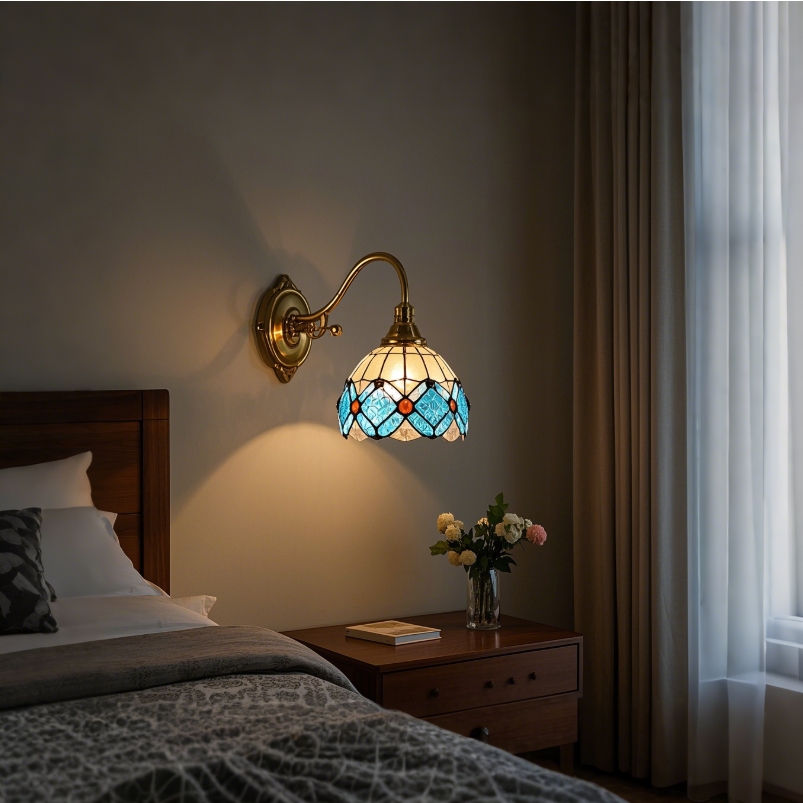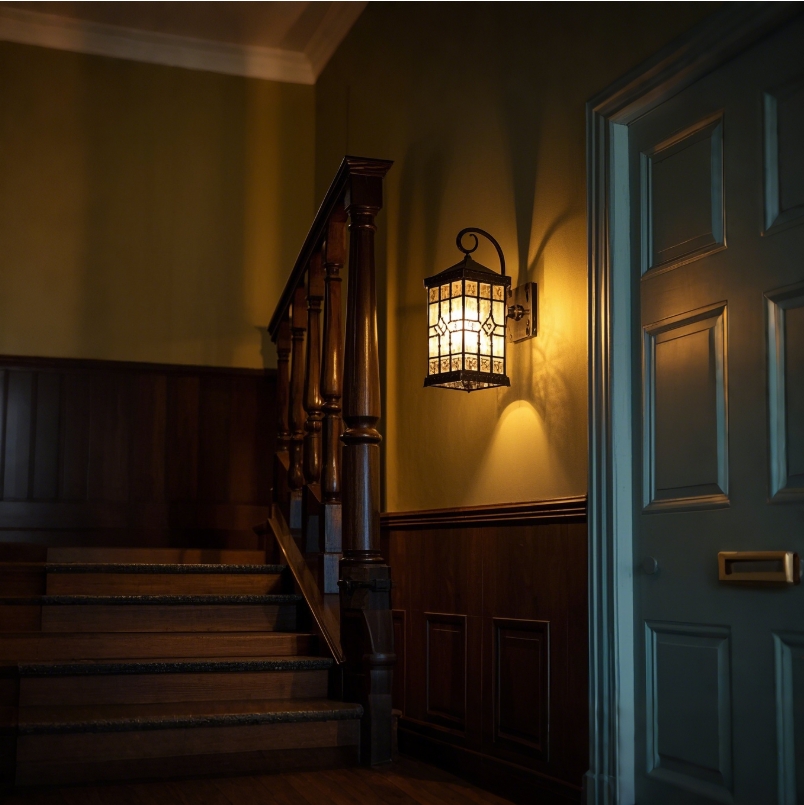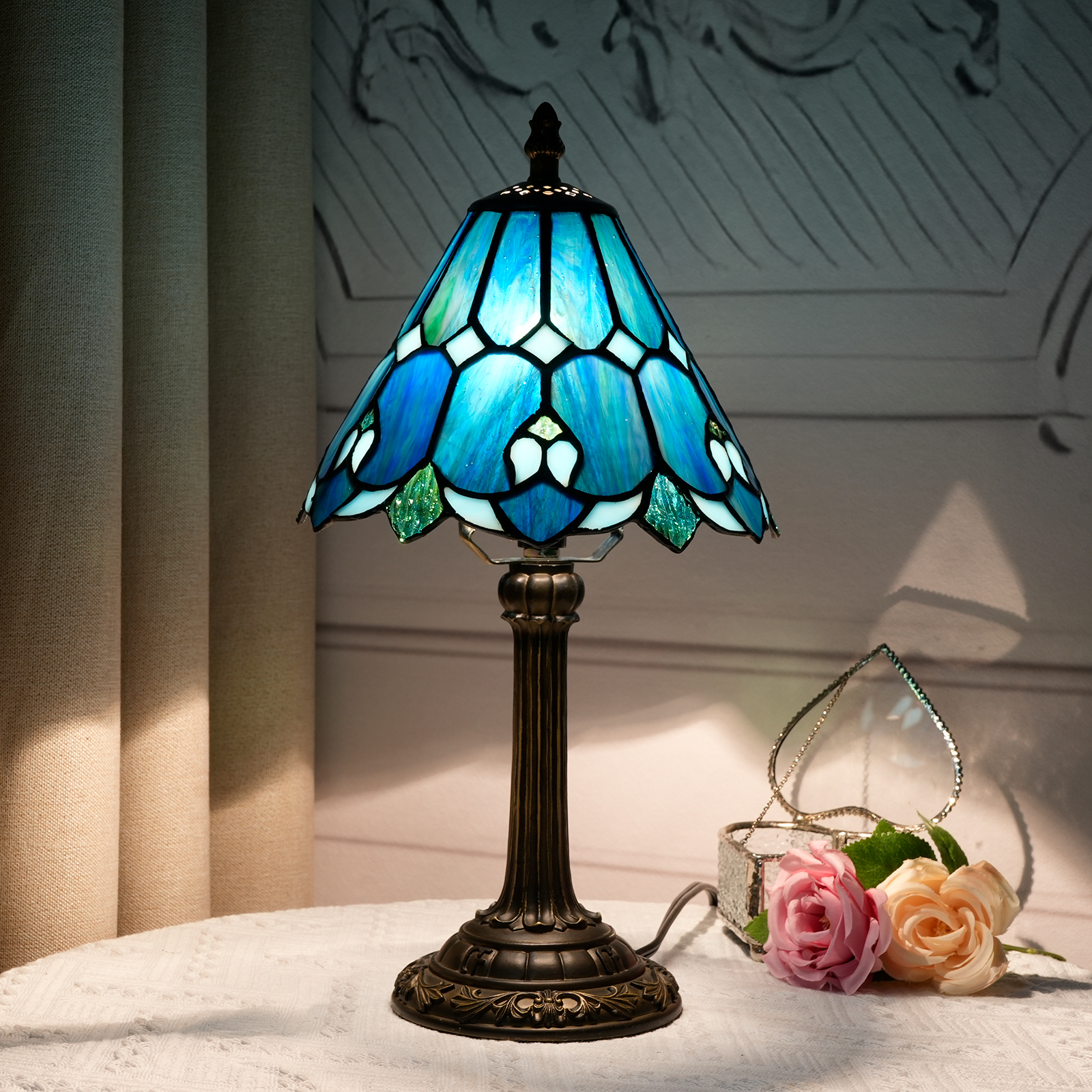《Tiffany Wall Lamp: Eternal glory of classic design, Pearl of art in the corner of the Wall》TIffany Wall lamp Bedside lamp arm adjustable antique craft stained glass tiffany home design
The Tiffany wall lamp, a dazzling artistic treasure, was born in the United States in the late 19th century, created by the renowned artist and designer Louis Comfort Tiffany. At that time, the Art Nouveau movement was at its peak, advocating a return to nature and promoting the vibrant natural forms and fluid organic curves, rejecting the complexity and rigidity of traditional decorative styles. Louis Comfort Tiffany was deeply influenced by the spirit of this movement and skillfully combined the dynamic beauty of nature with unparalleled handicraft techniques, creating the unique Tiffany wall lamp, which became a distinguished representative of the Art Nouveau movement.
Innovations in Materials and Techniques
In terms of materials, Tiffany had a keen eye for innovation, introducing opal glass, a unique material known for its color and texture. By carefully blending various metal oxides, Tiffany created a soft and vibrant lighting effect, imparting unparalleled artistic charm to its wall sconces. In terms of technique, Tiffany was also unique, inventing the copper foil technique. This technique broke the limitations of traditional lead-lined glass and used copper foil to wrap the edges of each colored glass piece, which was then soldered in place with tin. Not only did this make the connection between glass pieces tighter and more secure, but it also greatly expanded the design possibilities, enabling more intricate and complex pattern combinations, giving Tiffany's wall sconces an unprecedented level of richness and vitality in terms of shape and design.
Design Style and Inspiration
The design style of the Tiffany wall lamp is centered around naturalism, drawing inspiration from a wide range of elements in nature, such as flowers, plants, and insects. For example, the classic purple wisteria pattern wall lamp vividly recreates the elegant posture and vibrant colors of wisteria flowers on the lamp shade, exuding a sense of vitality and inviting viewers into a poetic natural world. In addition, Tiffany wall lamps also feature designs with geometric shapes and abstract patterns, showcasing a minimalist aesthetic that is not lacking in modern sensibility. They are suitable for both classical interior decoration and seamless integration with modern minimalist spaces, demonstrating their unique charm that transcends time.
Development and Popularity
In the late 19th century to the early 20th century, as people's appreciation for interior decoration and handicrafts grew, the Tiffany wall lamp quickly gained popularity among consumers due to its outstanding artistic value and decorative effects. The Tiffany Studio participated in various international exhibitions, showcasing the unique charm of the Tiffany wall lamp to the world and greatly enhancing its brand awareness and international influence. Meanwhile, many celebrities and wealthy individuals regarded the Tiffany wall lamp as a symbol of status and taste, and competed to collect it, further driving its trend of popularity.
Legacy and Impact
To this day, the Tiffany wall lamp remains a classic example of decorative lighting fixtures, retaining its high artistic value and collectible value, and is cherished by major museums and collectors around the world. Its unique design style and exquisite craftsmanship not only provide valuable inspiration for modern lighting design, but also stimulate the creativity of generations of designers, enabling it to continue radiating timeless charm in contemporary home decor.

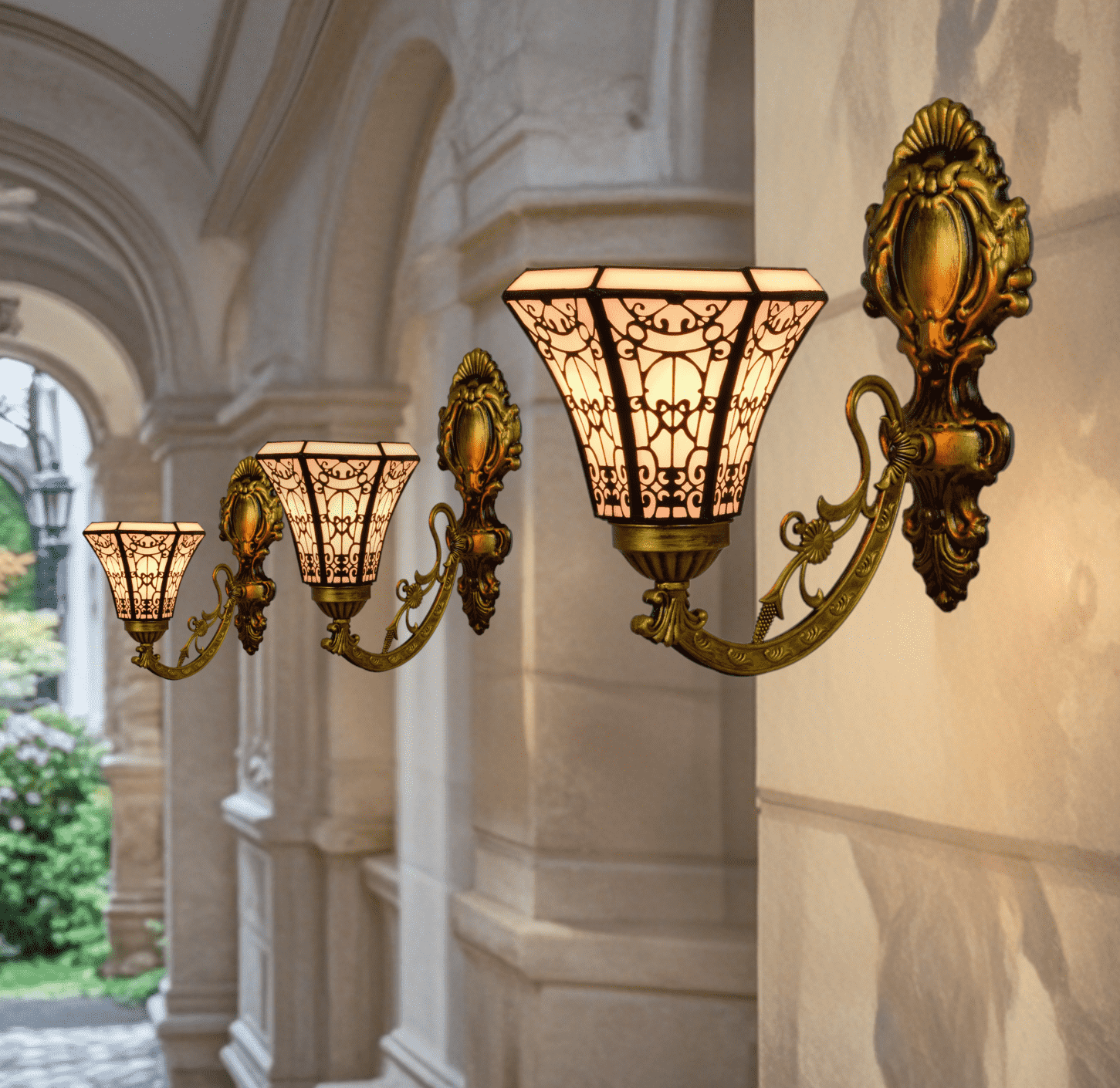
As an important member of the Tiffany lighting family, Tiffany wall lamps not only inherit the classic characteristics of Tiffany lamps, but also the extraordinary charm of unique wall lamps.
In terms of style, Tiffany wall lamps continue the essence of the Art Nouveau period. Its shape often takes natural elements as inspiration source, such as winding vines, blooming flowers and smart birds. These natural beauties are cleverly integrated into the decoration of wall lamps, giving them infinite vitality and agility. The color collocation is rich and gorgeous, as if the beautiful colors of nature are directly embedded in the wall lamp. For example, the flower theme wall lamps with pink and purple tones are like freezing the beauty of the spring garden, emitting soft and charming light when lit, creating a romantic and warm atmosphere, perfect for European classical style or pastoral style interior decoration. If the blue, green color is the main color, it can create a fresh and quiet feeling, and complement the natural elements in the Mediterranean style or modern simple style, adding a elegant and comfortable space.
In the applicable scene, Tiffany wall lamp with its unique artistic temperament, in the living room can become a visual focus. When the light shines through the exquisite stained glass lampshade, it casts a dreamy light and shadow on the wall, instantly enhancing the artistic style and taste of the living room. In the bedroom, it can create a quiet and comfortable sleep environment, soft light to accompany people to sleep, as if the whole bedroom is enveloped in a gentle dream. For restaurants, Tiffany wall lamps can add a sense of ceremony to the meal time, and their elegant light illumines the table, allowing food and art to complement each other, creating a unique dining atmosphere. In the study, it can not only provide a suitable light environment for reading and thinking, but also stimulate people's inspiration and creativity with its artistic charm, so that the study is not only a space for learning and working, but also a spiritual corner full of culture and art.
With its exquisite craftsmanship, unique style and wide applicability, Tiffany wall lamps are unique among many lamps, whether it is to add an artistic atmosphere to the home space, or to enhance the style and taste of commercial places, they show an irreplaceable value and charm.
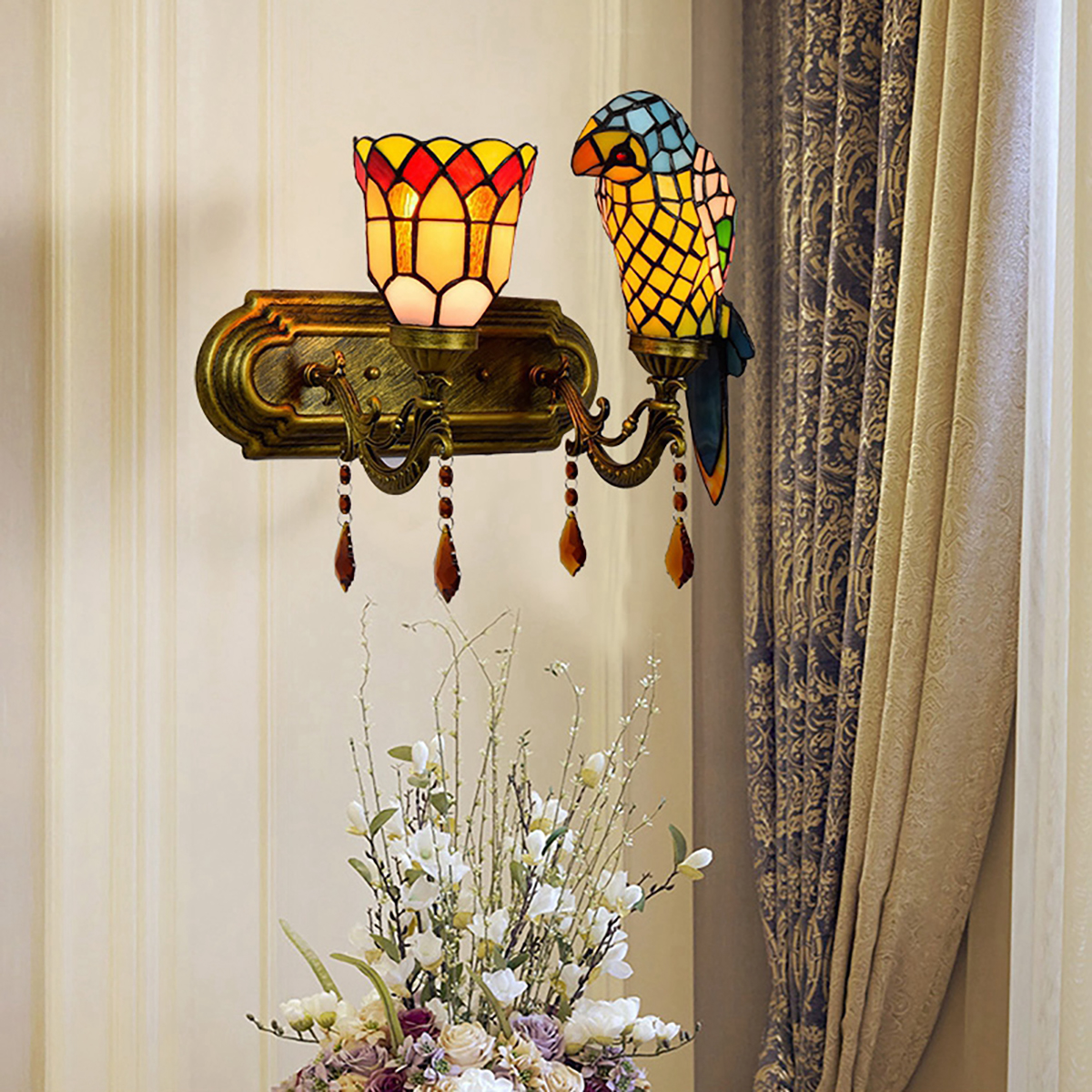

The manufacturing process for Tiffany wall lamps usually includes the following steps:
Design and planning: Determine the design style, size and structure of the wall lamp. This may involve hand sketching or using computer aided design (CAD) software to create detailed design drawings.
Material preparation: Select the appropriate material according to the design requirements. Tiffany wall lamps usually use stained glass, copper foil, tin wire and other materials.
Glass cutting: Using professional glass cutting tools, the colored glass is cut into the desired shape and size according to the design drawings. This requires precise measurements and skill to ensure a tight splicing of the glass pieces.
Glass grinding: The edge of the cut glass is polished to make it smooth and avoid scratches.
Copper edge: Copper foil is wrapped around the edge of the glass sheet to increase the strength and stability of the glass, and to facilitate welding.
Lamp shade welding: the glass sheet covered with copper edge is welded together with tin wire according to the design pattern to form the main structure of the lamp shade.
Copper-tin coloring cleaning: the copper-tin part after welding is colored to make it show the desired color and texture. It is then cleaned to remove impurities and oxides from the surface.
Protective oil: Apply a layer of protective oil on the surface of the lampshade to protect the glass and metal parts and increase the durability of the wall lamp.
Lamp body assembly: the lamp shade and lamp holder, wire and other components are assembled to ensure the normal function of the wall lamp.
Quality inspection: The quality inspection of the completed Tiffany wall lamp is carried out to check whether the welding is firm, whether the glass is defective, and whether the lighting effect meets the requirements.
Packaging and transportation: Qualified wall lamps are packaged to protect them from damage during transportation and storage.
It is important to note that the manufacturing process of Tiffany wall lamps may vary by manufacturer and designer. Some manufacturers may employ traditional hand-made methods, while others may use modern production techniques and equipment. In addition, the production process of Tiffany wall lamps also requires experienced craftsmen and professional equipment to ensure the production of high quality products.





Early style: Influenced by the Art Nouveau movement, Tiffany wall lamps at the end of the 19th century were mostly themed with natural elements, such as flowers, insects, plants, etc., and focused on curves and asymmetry in modeling, rich and soft colors, such as the classic wisteria flower pattern wall lamps, showing a naturalistic style, which was in line with the gorgeous and complex interior decoration style popular at that time.
Middle style: At the beginning of the 20th century, Tiffany wall lamps on the basis of maintaining natural elements, the design is more concise, geometric shapes and abstract patterns gradually increased, the color is more vivid, reflecting the concise and functionalist concept of modernism, began to integrate with the modern simple style of interior design to adapt to different decoration styles and aesthetic needs.
Modern style: Today's Tiffany wall lamps in the inheritance of classic elements at the same time, continuous innovation and development, integration of modern materials and crafts, design style is more diversified, not only retains the traditional artistic charm, but also shows the characteristics of fashion and personality, can meet the decorative needs of various styles of space.
Thoughts of art movement
Art Nouveau Movement: At the end of the 19th century, the Art Nouveau movement emphasized natural forms and organic curves, pursued the vitality and vitality of natural things, and opposed the traditional decorative style. Tiffany wall lamps were born in this period, influenced by it, the early Tiffany wall lamps mostly took natural elements as the theme, such as flowers, insects, plants, etc., paying attention to curves and asymmetrical shapes, rich and soft colors, showing a naturalistic style.
Art Deco Movement: In the early 20th century, the Art Deco movement arose, characterized by geometric shapes, symmetrical compositions, and clean lines, while incorporating elements of modern industrial civilization. Influenced by this, the design style of Tiffany wall lamp gradually changed, geometric shapes and abstract patterns gradually increased, and colors were more vivid, reflecting the concise and functional concepts of modernism, and began to integrate with the modern minimalist style of interior design.
Social and cultural environment
Aesthetic preferences in different periods: People in different times have different aesthetic concepts and lifestyles, which also affect the style evolution of Tiffany wall lamps. For example, at the end of the 19th century and the beginning of the 20th century, people were fond of gorgeous and complex decorative styles, so the design of Tiffany wall lamps paid more attention to details and decoration; In modern times, people's aesthetic is more inclined to simple, natural and personalized, Tiffany wall lamp design is also more simple, fashion, pay attention to the integration of modern home environment.
Cultural exchange and integration: With the development of globalization, the exchange and integration between different cultures are becoming more and more frequent. Tiffany wall lamps also absorb elements of different cultures in the development process, such as Zen and simplicity in Eastern culture, making its design style more diversified and able to meet the needs of consumers with different cultural backgrounds.
The development of the production process
Material innovation: Tiffany wall lamp production materials continue to enrich and innovate, from the original colored glass, copper foil, metal and other traditional materials, to modern new glass materials, composite materials, etc., the application of these materials for Tiffany wall lamp design provides more possibilities. For example, the new glass material has better light transmission, color expression and durability, so that Tiffany wall lamp lampshades can show a more colorful effect.
Technological advances: The continuous progress of the production process has also promoted the evolution of Tiffany wall lamp style. From the traditional hand-made process to the application of modern mechanized production, laser cutting, 3D printing and other advanced technologies, it not only improves production efficiency and product quality, but also enables more complex and fine design patterns and shapes, making the style of Tiffany wall lamps more diversified and modern. For example, the use of CAD/CAM technology can accurately design and produce a variety of shapes and patterns of lampshades, to achieve the traditional process difficult to achieve the effect.
Market demand and functional changes
Diversification of market demand: With the improvement of people's living standards and the continuous development of the home decoration market, consumers' demand for Tiffany wall lamps is becoming more and more diversified. In addition to the traditional decorative functions, consumers also pay more attention to the lighting effect of the wall lamp, energy saving, environmental protection and other practical functions. In order to meet the market demand, Tiffany wall lamp design retains the artistic style on the basis of continuous integration of modern technology elements to improve its lighting performance and practicality.
The development of space design: The concept and style of modern interior space design are also constantly changing, and the transformation from traditional closed Spaces to open, multi-functional Spaces has put new requirements on the design of Tiffany wall lamps. Tiffany wall lamps need to pay more attention to the coordination and unity of the overall space environment, and carry out customized design according to different spatial functions and layouts to adapt to the development trend of modern space design.
Designer's personal style and innovation
Designer heritage and innovation: Designers from different periods have played an important role in the design of Tiffany wall lamps. On the basis of inheriting Tiffany's traditional style, they continue to integrate their own design concepts and innovative elements, which has promoted the evolution of Tiffany's wall lamp style. For example, some designers combine elements of modern art and pop culture with the classic design of Tiffany wall lamps to create pieces with a unique personality and sense of The Times.
Cross-field cooperation and innovation: Tiffany wall lamp design also often carries out interdisciplinary cooperation and innovation with other fields, such as cooperation with architecture, interior design, fashion and other fields. By communicating and collaborating with professionals in different fields, designers are able to gain more inspiration and creativity, and inject new vitality into the style evolution of Tiffany wall lamps.
Application of different scenarios
Living room: Tiffany wall lamps can be installed on the sofa background wall of the living room, on both sides of the fireplace or in the aisle, adding a warm and romantic atmosphere to the living room, and can also be used as a decorative element to enhance the overall style of the living room.
Bedroom: In the bedroom, Tiffany wall lamps are usually installed on both sides of the bed or in front of the dresser, providing soft lighting to create a comfortable and quiet sleeping environment, and its exquisite shape and soft light also help relax the body and mind, improve the comfort and beauty of the bedroom.
Restaurant: Tiffany wall lamps in the restaurant can be installed on both sides of the table or over the side counter to provide suitable light for dining, but also to add an elegant and romantic atmosphere to the restaurant, making the dining process more pleasant.
Hallways and stairwells: Installing Tiffany wall lights in hallways and stairwells can provide guidance and lighting, while also adding an artistic atmosphere to these Spaces.

